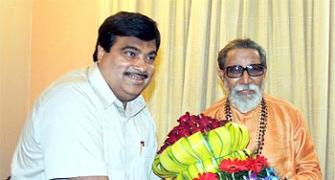 Hindutva was arguably one of the big political ideas of the 1990s. The Bharatiya Janata Party may have begun nurturing it earlier, but it was only during the last decade of the 20th century that the idea manifested itself as a powerful concept to earn for its practitioners rich electoral dividends.
Hindutva was arguably one of the big political ideas of the 1990s. The Bharatiya Janata Party may have begun nurturing it earlier, but it was only during the last decade of the 20th century that the idea manifested itself as a powerful concept to earn for its practitioners rich electoral dividends.
Hindutva was also the BJP's response to V P Singh's bold move in the wake of the Mandal Commission recommendation to extend the reservation policy to cover backward communities. This threatened to split the Hindu vote bank and sent out alarm signals for the BJP. As it turned out, the politics of reservation proved less potent an instrument for gaining political power than Hindutva. So did the policies of economic reforms and growth, ushered in by the P V Narasimha Rao-Manmohan Singh duo at around the same time.
The BJP used very effectively the Hindutva wave, which it unleashed with careful political planning after the demolition of the disputed structure in Ayodhya in 1992. In the following years, the party used the wave to expand its political influence across the country. It, of course, realised by 1996 that the Hindutva agenda would not help it form a government at the Centre on its own. Thus, by 1998, the BJP struck useful alliances with a few regional parties and chose a leader who presented a more moderate Hindutva face and, therefore, was acceptable to its alliance partners. The idea was to form a government at the Centre. The party achieved that objective in 1998 and the same experiment worked in 1999.
The decade of the 1990s, therefore, saw the emergence of Hindutva as a winning political idea, though with minor modifications and adjustments. Most significantly, it defeated other ideas like those of affirmative action for backward communities and economic reforms. Indeed, so powerful was the Hindutva wave in the latter half of the 1990s that no other idea seemed to be on the horizon that could even challenge the dominance of Hindutva propagated by the BJP. That sense of triumph, in fact, emboldened the saffron party to combine Hindutva with India's economic growth potential as a new political idea to help the party fight the elections in 2004.
The BJP alliance failed to retain power after the general elections in May 2004. This, though, was no comment on the efficacy of Hindutva. The BJP alliance's loss was largely attributable to the choice of a few of its new partners. Together with the BJP, they failed to garner the required number of seats in the Lok Sabha to stay ahead of the Congress-led formation, the United Progressive Alliance, which eventually formed the government in 2004.
What, however, did have a telling impact on the efficacy of Hindutva was the kind of policies and politics the UPA pursued. The aam-aadmi politics of Congress president Sonia Gandhi successfully challenged the idea of Hindutva by relying on the principles of economic and social inclusion of every underprivileged section of society. Indeed, the aam-aadmi net was wide and deep in a country whose range of socio-cultural diversity and economic deprivation was too huge to be managed by an exclusivist idea like Hindutva which, it must be noted, had no clearly defined economic agenda either.
The National Rural Employment Guarantee Programme, launched by the UPA with much fanfare, meant economic empowerment for the rural poor, cutting across caste, community and religion. There were several other schemes like protecting the rights of tribals, ensuring the people their right to information and providing health insurance for the poor. Together with the continued stress on affirmative action to reserve access to education and work for the underprivileged people, the aam-aadmi politics of the UPA turned out to be a comprehensive response to the Hindutva agenda of the BJP.
It took less than five years for the UPA to send the message out to people that its aam-aadmi agenda with an inclusive approach was a decidedly better option for them than the Hindutva message that appealed more to their emotion and sentiment and less to their basic socio-economic needs. BJP leaders realised this the hard way during the campaign for the 2009 general elections. They realised that the UPA's aam-aadmi agenda had changed the terms of election debates. Varun Gandhi's Hindutva message simply failed to fan a strong enough wave to sweep across the country.
In terms of political ideas, the first decade of the 21st century presented the satisfying spectacle of the aam-aadmi politics with inclusive socio-economic policies successfully challenging the idea of Hindutva. The decade had begun with the scary thought of the Hindutva agenda growing deep roots in this country, as its practitioners tried to combine it with the idea of an economically resurgent India. The decade ends with the realisation that such divisive ideas have finally been challenged by an inclusive brand of aam-aadmi politics. The Left may have played a role in this. But the shift in the direction of India's politics is unmistakable and has to be welcomed.
Image: Former BJP chief Rajanth Singh at a religious function








